 |
|
 |
 |
The Miata / MX-5 / Eunos Story |
 The team's goal was to achieve 55% "do-ability", allowing for 45% risk. As the Japanese word for "5-5" rhymes with "Go-Go", 'Offline 55' was deemed the perfect title for the project. In November 1983, Mazda launched 'Offline 55', an innovative new programme with the sole aim of encouraging revolution and experimentation in product development. This was a peek into the future… The team considered several proposals - a 323 convertible, an executive sports sedan, a mini 'space wagon' and a rotary-powered pickup. By far the favourite was an LWS - otherwise known as a light-weight sports car. The team's goal was to achieve 55% "do-ability", allowing for 45% risk. As the Japanese word for "5-5" rhymes with "Go-Go", 'Offline 55' was deemed the perfect title for the project. In November 1983, Mazda launched 'Offline 55', an innovative new programme with the sole aim of encouraging revolution and experimentation in product development. This was a peek into the future… The team considered several proposals - a 323 convertible, an executive sports sedan, a mini 'space wagon' and a rotary-powered pickup. By far the favourite was an LWS - otherwise known as a light-weight sports car. |
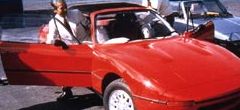 The one and only example of the V705 was ready in October 1985. It was then given its first tentative outing on the roads of Santa Barbara in the USA. In 1984, under the close watch of programme manager Masakatsu, two styling teams were tasked with creating the design for the LWS in tandem - one in California, the other in Tokyo. It was a close race, but by the end of that year, the Californian team's front-engine, rear-wheel-drive roadster emerged triumphant. It was code-named the P279. A running prototype, the V705, was engineered and built by Britain's International Automotive Design. The one and only example of the V705 was ready in October 1985. It was then given its first tentative outing on the roads of Santa Barbara in the USA. In 1984, under the close watch of programme manager Masakatsu, two styling teams were tasked with creating the design for the LWS in tandem - one in California, the other in Tokyo. It was a close race, but by the end of that year, the Californian team's front-engine, rear-wheel-drive roadster emerged triumphant. It was code-named the P279. A running prototype, the V705, was engineered and built by Britain's International Automotive Design. |
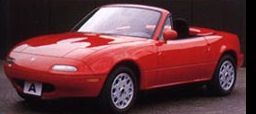 The power unit was developed from the B6 1.6 litre engine. This basic sedan engine was transformed for the MX-5 into a willing, high-revving sports car unit, earning a unique suffix, 'ZE'. As the car moved into the production phase, Toshihiko Hirai was appointed Product Programme Manager in February 1986. To move the project forward, he had to rethink the V705's steel backbone frame and plastic body in order to create a viable series production car - this was no mean feat! Over in the US, another round of changes were being made to the car's styling by Tom Matano and Koichi Hayashi. This was to become the design for the MX-5. The power unit was developed from the B6 1.6 litre engine. This basic sedan engine was transformed for the MX-5 into a willing, high-revving sports car unit, earning a unique suffix, 'ZE'. As the car moved into the production phase, Toshihiko Hirai was appointed Product Programme Manager in February 1986. To move the project forward, he had to rethink the V705's steel backbone frame and plastic body in order to create a viable series production car - this was no mean feat! Over in the US, another round of changes were being made to the car's styling by Tom Matano and Koichi Hayashi. This was to become the design for the MX-5. |
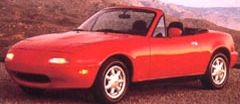 The car's name? MX stands for Mazda Experimental. The '5' was the next number in the sequence of 'M' concept cars. The Mazda MX-5 made its debut at the Chicago Motor Show in February 1989 to wide critical acclaim. The press hailed the car "a total success", "a car of the rarest quality" and one that boasted "exciting looks, fun to drive, sensible ergonomics, quality construction…we feel like cheering". The car's name? MX stands for Mazda Experimental. The '5' was the next number in the sequence of 'M' concept cars. The Mazda MX-5 made its debut at the Chicago Motor Show in February 1989 to wide critical acclaim. The press hailed the car "a total success", "a car of the rarest quality" and one that boasted "exciting looks, fun to drive, sensible ergonomics, quality construction…we feel like cheering". |
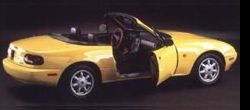 In 1991, 800 dazzling 'Sunburst Yellow' J Limited models went on sale in Japan. The US was similarly tempted by a limited run of 1,500 MX-5 models in the same outstanding colour. In 1993, in the face of ever tightening emissions standards in its major markets, coupled with new safety requirements (which would inevitably mean an increase in the vehicle's body mass), the MX-5 was given a new heart - its engine, which in it's 1.6 litre guise was in need of some extra oomph. Power came in the form of a new BP-ZE 1.8 litre four-cylinder engine for the MX-5. In 1991, 800 dazzling 'Sunburst Yellow' J Limited models went on sale in Japan. The US was similarly tempted by a limited run of 1,500 MX-5 models in the same outstanding colour. In 1993, in the face of ever tightening emissions standards in its major markets, coupled with new safety requirements (which would inevitably mean an increase in the vehicle's body mass), the MX-5 was given a new heart - its engine, which in it's 1.6 litre guise was in need of some extra oomph. Power came in the form of a new BP-ZE 1.8 litre four-cylinder engine for the MX-5. |
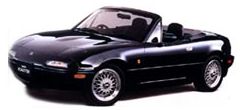 The MX-5 first generation's final season was marked by a commemorative model given a special 'STO' designation. 'STO' stands for 'Still the One' and was suggested by Mazda's US staff out of their great respect for Toshihiko Hirari - father of the first generation MX-5 and 'Still the One' programme manager. The second major update to the first generation MX-5 came in 1995. Improvements to the car's performance were achieved by the introduction of a lighter-weight flywheel and more powerful engine management computer. These combined to optimise the air/fuel ratio during high-speed operation. The MX-5 first generation's final season was marked by a commemorative model given a special 'STO' designation. 'STO' stands for 'Still the One' and was suggested by Mazda's US staff out of their great respect for Toshihiko Hirari - father of the first generation MX-5 and 'Still the One' programme manager. The second major update to the first generation MX-5 came in 1995. Improvements to the car's performance were achieved by the introduction of a lighter-weight flywheel and more powerful engine management computer. These combined to optimise the air/fuel ratio during high-speed operation. |
 "We like to think of it as an MX-5 that has been working out at the gym, adding muscle and tone." Tsutomu Tom Matano, executive designer of Mazda's Irvine, California R&D studio. In the spring of 1994, Mazda began the process of building the next generation MX-5. More stringent safety requirements meant changes to the body's inner structure, which would have an effect on the look of the car. The design was an evolution of the original concept, rather than revolution. The new MX-5 was launched in 1999. It's new contoured headlights and sleek muscular body confirmed its status as a design classic. Enhanced performance came in the form of increased stability and a more sporty, responsive feel thanks to revised engine and suspension tuning. "We like to think of it as an MX-5 that has been working out at the gym, adding muscle and tone." Tsutomu Tom Matano, executive designer of Mazda's Irvine, California R&D studio. In the spring of 1994, Mazda began the process of building the next generation MX-5. More stringent safety requirements meant changes to the body's inner structure, which would have an effect on the look of the car. The design was an evolution of the original concept, rather than revolution. The new MX-5 was launched in 1999. It's new contoured headlights and sleek muscular body confirmed its status as a design classic. Enhanced performance came in the form of increased stability and a more sporty, responsive feel thanks to revised engine and suspension tuning.
|
|
 |
 |
|
 |
|
|